Essential Guide to Choosing Sandals for Seniors

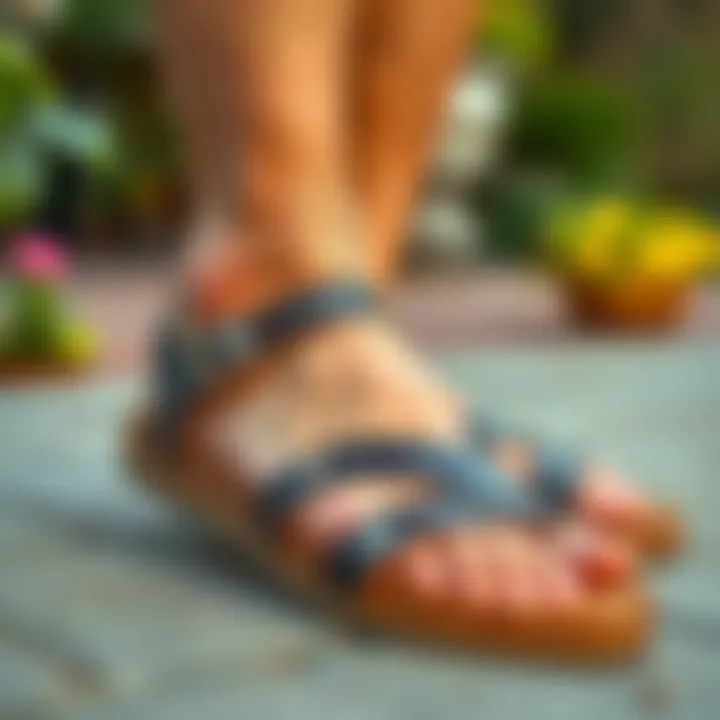
Intro
Selecting the right sandals for the elderly is not merely a matter of aesthetics; it revolves around ensuring comfort, safety, and ease of use. Not only do well-chosen sandals enhance the quality of life for seniors, but they also facilitate mobility and independence. In this article, we’ll delve into key aspects to consider when picking out sandals designed for older adults, from features that support stability to materials that promote comfort. Furthermore, we’ll provide insights that not just help the elderly but also assist family members and caregivers in making informed decisions.
The market offers a wide range of options, which can often lead to confusion. However, a focused approach can simplify the selection process. By emphasizing certain design elements such as cushioning, arch support, and friction-resistant outsoles, we can tailor our choices to meet the unique needs of elderly wearers. We aim to highlight the importance of style combined with practicality, as the days of sacrificing fashion for function are falling by the wayside.
Let’s get started on this journey to find the perfect sandals that meld utility with a touch of flair.
Prelims
When older adults select sandals, they must consider multiple elements like support, comfort, and stability. It’s not just a foot issue; it’s a matter of overall wellbeing. Research indicates that inappropriate footwear contributes to falls, which are a leading cause of injury among seniors. Thus, discussing the characteristics of suitable sandals becomes paramount for enhancing both their quality of life and safety.
Moreover, as we unravel the implications of suitable footwear, it's key to recognize how the right pair of sandals can help maintain a sense of dignity. Many older individuals cherish their sense of style and want footwear that complements their personal aesthetic. Therefore, a careful balance between function and fashion is essential.
In this guide, we explore the factors to consider in choosing sandals that align with the needs of elderly individuals. Understanding their unique challenges and preferences forms the core of this narrative. As we delve into this topic, it becomes clear that thoughtful selection fosters mobility, comfort, and dignity for the elderly.
Understanding the Needs of Elderly Footwear
Choosing the right footwear for elderly individuals goes beyond mere aesthetics or trendiness; it’s about ensuring their comfort, safety, and overall well-being. As we age, our feet undergo various changes that warrant special attention when selecting sandals. Understanding these needs is crucial for family members and caregivers, as well as elderly individuals themselves.
Elderly footwear must balance support, stability, and ease of use. Foot health is often overlooked, but it plays a pivotal role in maintaining mobility and independence for older adults. Sandals that are thoughtfully designed can alleviate common foot issues and enhance a person’s quality of life. For instance, choosing sandals with a deeper toe box can help accommodate conditions such as bunions or hammertoes, which are prevalent in older adults.
In considering this topic, we must highlight the following key elements:
- Foot anatomy changes with age, leading to a need for footwear that provides adequate support and cushioning.
- Balance can become compromised, increasing the risk of falls. The right sandals play a vital role in enhancing stability.
- Foot problems can vary from arthritis to plantar fasciitis, making it essential to consider specific features designed to address these discomforts.
Elderly footwear must consider the specific elements of foot design and materials. For those experiencing reduced dexterity, sandals should be easy to put on and take off, further promoting independence. Thus, understanding these diverse needs lays a solid foundation for making informed footwear choices that will resonate with elderly wearers.
Common Foot Problems in the Elderly
Feet don't last forever, particularly as we march through life. Among the prevalent foot issues faced by older adults, arthritis is a major contender. This inflammation can lead to joint pain, stiffness, and reduced mobility, making it imperative to choose sandals that feature good arch support and cushioning. Many sandals lack proper features that can ease these discomforts, leading to unnecessary pain.
Another common ailment includes plantar fasciitis, characterized by intense pain at the heel and bottom of the foot. Wearing sandals that provide good arch support and shock absorption can significantly alleviate this discomfort. Sometimes, elderly individuals may also encounter bunions, hammertoes, or neuropathy, which require special attention in footwear selection.
Balance and Stability Considerations
As we age, maintaining balance becomes increasingly important. Poor balance heightens the risk of falls, a serious concern for the elderly. The right sandals can play a crucial role in enhancing stability, allowing seniors to walk with confidence.
Look for sandals that feature a wide base and are lightweight, improving stability during movement. Non-slip soles are a must, offering better grip on various surfaces. Some sandals even come with adjustable straps to provide a snug fit, preventing the foot from sliding within the sandal, which can lead to instability or, worse, falls.
In summary, understanding the unique needs of elderly footwear is not just advantageous—it’s essential. From addressing common foot problems to prioritizing balance and stability, the right sandals help create a safer and more comfortable experience for elderly individuals.
Essential Features of Sandals for the Elderly
Choosing sandals for seniors goes beyond a mere fashion statement; it’s about enhancing safety, comfort, and overall well-being. Essential features in elder sandals are critical not only for daily wear but significantly contribute to the quality of life. Understanding what to look for is paramount. Here’s a closer look at the key components that set suitable sandals apart from the rest.
Arch Support and Cushioning
At the heart of any good sandal, especially for the elderly, is arch support and cushioning. These elements play a huge role in providing comfort, especially for those who may experience foot pain or fatigue after long periods of wear. Arch support helps align the foot properly, alleviating pressure on the joints. This isn’t just a luxury; it’s a necessity. A poorly supported foot can lead to a ripple effect of discomfort extending through the legs and back.
Cushioned soles absorb shock, providing a softer landing for each step. Think about walking in the park or even just around the house. With proper cushioning, seniors can enjoy these simple activities without a second thought regarding foot discomfort. Walking shouldn’t feel like a chore, and having a well-cushioned sandal can make all the difference in staying active and engaged.
Adjustability and Comfort
Seniors often have unique needs when it comes to footwear. Adjustability is a pivotal element to consider in sandals designed for the elderly. Adjustable features ensure a snug fit, catering to fluctuating foot sizes or shapes due to conditions like swelling. This is where the true value of adjustable straps becomes apparent.
Hook-and-loop Straps
Hook-and-loop straps, often recognized by the brand name Velcro, are particularly beneficial. These straps allow for quick adjustments, which can be especially crucial for seniors who may struggle with dexterity. Imagine someone who finds it hard to bend down—these straps can be easily adjusted with a simple tug, offering both security and comfort.
The key characteristic of hook-and-loop straps is their versatility. They also provide weight distribution across the foot, reducing pressure points. This means a more pleasant wearing experience, less likelihood of blisters, and ultimately, more time spent on their feet without discomfort. However, one potential downside could be durability; over time, the adhesive can wear down, though many brands have designed their straps to combat this.
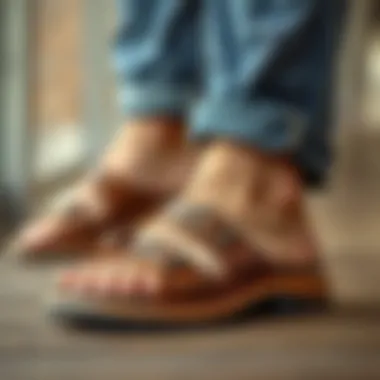
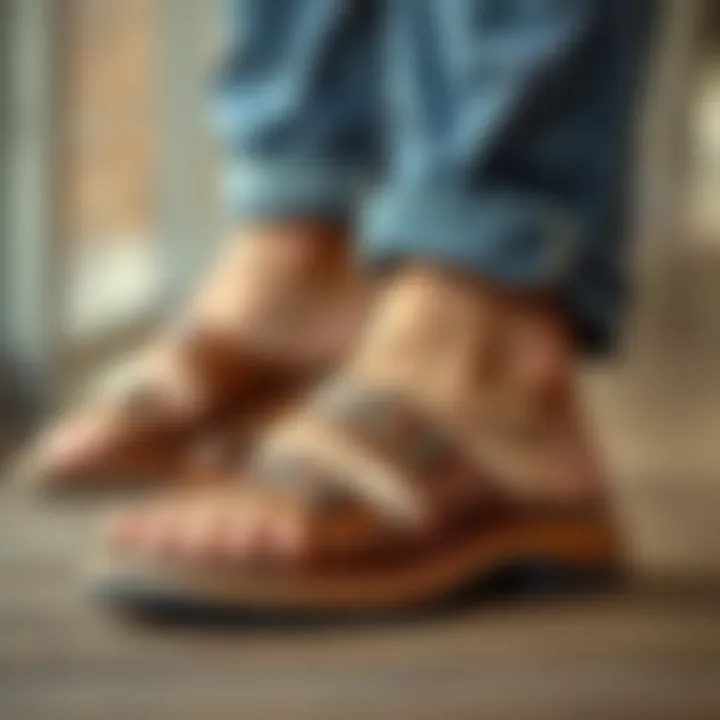
Elastic Materials
Another noteworthy feature is elastic materials. These are used in various sandal designs to allow for flexible movement and ease of entry. Elastic bands conform to the foot, making it effortless for an elderly person to slide their foot into the sandal without wrestling with buckles or laces.
The benefit of elastic materials lies in their ability to offer a balanced fit. The stretchiness accommodates different foot shapes and sizes; one day they might feel tighter, while another day, they feel just right. This adaptability adds comfort, making these materials valued in elderly footwear. On the flip side, some might argue that elastic can lose its stretch over time, which is a valid concern as it could impact the fit. A well-made elastic should resist this wear and keep providing comfort.
Non-Slip Soles for Safety
Lastly, but crucially, non-slip soles are an absolute must in the design of sandals for the elderly. The potential for slips and falls is a serious concern, particularly for seniors. Non-slip soles, often made from rubber or specialized high-traction materials, offer grip that helps prevent accidents on slippery surfaces.
With effective traction, seniors can move more confidently, whether they are in the garden or walking on hardwood floors inside. A good non-slip sole will integrate a tread pattern that varies depending on the intended use, ensuring that wearers feel secure in their movements. The peace of mind that comes from knowing their sandals will keep them steady on their feet can make daily life significantly more enjoyable.
In summary, the essential features of sandals for the elderly are a blend of support, adaptability, and safety. By focusing on these aspects—arch support, cushioning, adjustability through various straps, and non-slip soles—families and caregivers can make informed choices that enhance the well-being of their loved ones. Each of these features contributes to a greater sense of independence and security, ultimately leading to a better quality of life.
Types of Sandals Suitable for the Elderly
Selecting the right type of sandals is paramount for elderly individuals, given the unique challenges they face related to foot health and comfort. The right sandals not only enhance mobility but also promote safety, which is vital as falls remain one of the leading causes of injury in seniors. Elderly-friendly sandals need to balance functionality with comfort while still aligning with personal style preferences. Keeping these considerations in mind invites a deeper look into the various categories of sandals available.
Flip-Flops and Slides
Flip-flops and slides provide a lightweight option that can be appealing to many. Their effortless design allows for easy wear; however, not all flip-flops are made equal. Many casual flip-flops lack arch support, which is critical for anyone with foot issues. When considering flip-flops for seniors, opt for styles that offer a more contoured footbed. Some models even offer cushioned soles that can help mitigate impact as they walk.
A big advantage of slides is their ease of use. Unlike many closed-toe options, slides require minimal effort to put on, making them accessible for seniors with limited dexterity. It's worth noting that while they allow for breathability—an important factor during warmer months—one should also be cautious about stability. Choosing slides with a secure fit can prevent unnecessary slipping.
"Choosing the right footwear is not just about style; it can significantly impact overall mobility and safety for the elderly."
Sport Sandals
Sport sandals are another compelling option for older adults who enjoy an active lifestyle. They are constructed to offer adequate arch support and stability while providing breathability. Many models come with adjustable straps that ensure a snug fit, essential for maintaining security while walking on uneven terrain.
When looking for sport sandals, pay attention to the rubber outsole. A non-slip tread can dramatically increase grip, ensuring that the wearer feels secure even when walking on wet surfaces. This feature is particularly important as seniors need footwear that helps them navigate different environments. Sport sandals are ideal for those who might engage in outdoor activities or simply require durable footwear for day-to-day errands.
Moreover, the versatility of sport sandals allows for easy transition from casual outings to more active settings, making them a practical choice.
Dress Sandals
For occasions that require a more polished appearance, dress sandals can be an excellent choice for elderly individuals. While they often prioritize aesthetics, that doesn't mean they can’t be comfortable. Many dress sandals nowadays are designed with ergonomic principles in mind, ensuring that seniors do not have to sacrifice comfort for style.
When selecting dress sandals, look for features such as a cushioned footbed and adjustable straps, which can help adapt to varying foot shapes. These sandals typically offer a more refined appearance but should still adhere to the basic safety requirements discussed earlier. Additionally, consider the heel height; a lower heel is generally safer and provides better stability.
In essence, while dress sandals may fit in at social gatherings, they should still prioritize comfort and function. This balance is invaluable for older adults who want to enjoy special moments without enduring pain or instability.
Choosing the right type of sandal involves understanding both the needs of elderly wearers and their lifestyle. Each type—from easy-going flip-flops to sporty, functional sandals to elegant dress options—offers distinct benefits that align with various preferences and activities. By focusing on supportive, easy-to-wear options, you can significantly enhance mobility and overall well-being.
Material Choices for Elderly Sandals
Selecting the right materials for elderly sandals is critical. The fabric and construction can greatly affect comfort, support, and longevity. In an age where mobility can diminish, the right sandals can be a pivotal factor in promoting a more active lifestyle. It’s like choosing a trusty steed for a this journey; if the materials are wrong, the ride gets bumpy.
Breathable Fabrics
One of the key elements in choosing sandals is breathability. Fabrics like mesh or soft leather allow airflow, keeping feet cool and dry, which is vital for preventing conditions like athlete's foot or blisters. They act like a breath of fresh air – quite literally – for tired feet. When the temperature rises or if there’s a slight drizzle, these materials help in wicking away moisture.
Consider options such as synthetic mesh, which is lightweight and often designed to hug the foot while allowing for ventilation. This can provide that snug fit without the stuffiness. When speaking about sandals crafted from such materials, comfort blends seamlessly with functionality. Look for those that have built-in cushioned linings, as they only add to the overall experience for the wearer.
Durable Outsoles
Next up is the outsole material. Sandals made with durable rubber or EVA (ethylene-vinyl acetate) provide flexibility and resistance to wear and tear. This, of course, is essential for elderly folk who may shuffle instead of stride. The last thing anyone wants is a sad-looking sandal after just a few outings.
The durability of the outsole contributes to the overall safety of the sandals, too. When choosing shoes for the elderly, one wants to ensure they can withstand various terrains without losing grip. A good tread pattern not only supports stability but also enhances traction. Everyone knows those tumble weeds can roll in when least expected; having well-made outsoles can prevent unwanted tumbles or slips on smooth and slippery surfaces.
Water-Resistant Options
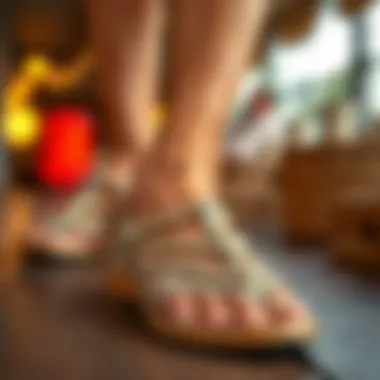
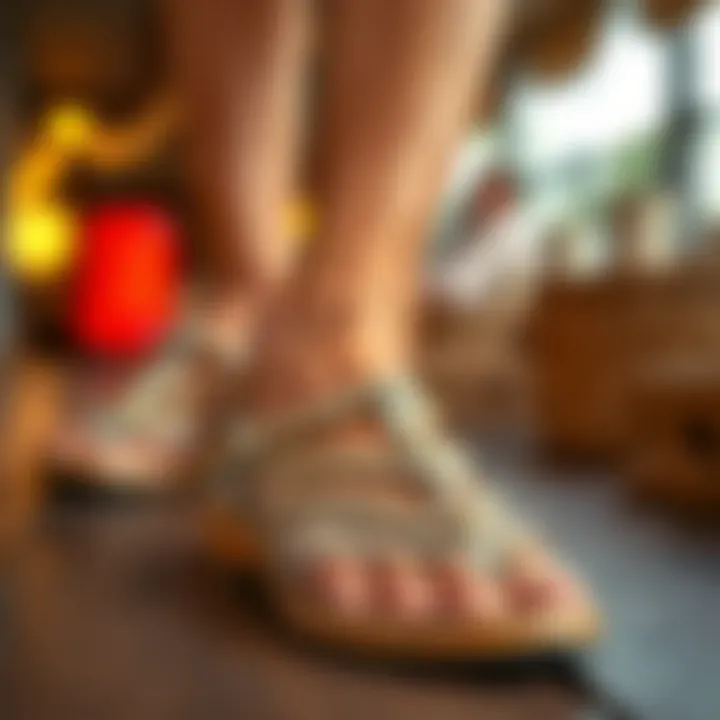
Lastly, don't overlook the aspect of water resistance. Sandals made from materials that resist water damage will keep wearing well even when exposed to puddles or spills. Waterproof uppers, often made from synthetic materials, offer peace of mind when traversing wet environments or even washing up the dog.
For those who enjoy an outing near water, having that extra layer of protection from absorption can extend the life of the sandals. A notable option includes sandals fitted with water-repellent coatings. They can dry quicker and prevent soggy socks from putting a damper on a sunny day. This selects the right companions for outings, making every step count.
"Good footwear isn’t just about style, it’s about giving freedom to walk with confidence."
When considering sandals, remember that quality materials provide more than just aesthetics. They play a key role in ensuring safety, comfort and durability in every step taken.
For further information on materials and foot health, you might find this study from the Journal of Foot and Ankle Research insightful.
Evaluating Fit and Sizing
When it comes to sandals for the elderly, one of the most crucial factors is the fit. A good pair of sandals should hug the foot comfortably without constricting it. Getting the sizing right can make the difference between a good day out and a painful experience. Poorly fitted sandals can lead to discomfort, blisters, and even more significant foot issues down the line.
Importance of Proper Sizing
Choosing sandals that fit well should be treated less like a luxury and more like a necessity, especially for seniors. Improper sizing can cause myriad problems, such as increased risk of falls due to instability, or exacerbating existing foot conditions like bunions or arthritis. Even slight differences in size can drastically impact comfort.
A properly fitted sandal keeps the foot from slipping, which helps maintain balance. It’s essential that the toe area is neither cramped nor excessively loose. As a rule of thumb, there should be about a thumb's width of space between the longest toe and the front of the sandal. This ensures that when the elderly individual walks, they don’t stub their toes.
Trying Before Buying
In this digital age, it’s convenient to shop for sandals online; however, it’s particularly important to take the time to try on sandals in-store before purchasing. The elderly often have specific and varied foot shapes, which can make guessing their size online hit-or-miss. Going to a store allows them to walk around in the sandals, checking for any discomfort or pinching that they might not notice just standing still.
It’s also valuable to wear the type of socks they typically would with the sandals when trying them on. For those with foot swelling or changing foot sizes, it might also be worth considering going shopping later in the day when their feet are at their largest.
"A stitch in time saves nine" – a phrase that resonates with fitting shoes. The effort put into proper sizing goes a long way, sparing discomfort and possible health issues in the future.
By ensuring a proper fit, caregivers and seniors can enjoy their daily activities without the nagging worry of foot pain. Proper fit isn’t just about comfort; it’s about empowering mobility and independence for the elderly.
Hygiene and Maintenance of Sandals
Hygiene and maintenance are crucial aspects when it comes to selecting sandals for the elderly. Proper care not only extends the lifespan of the sandals, but it also plays a significant role in the foot health of older adults. A clean and well-maintained sandal can prevent various foot issues, from infections to discomfort, which can be especially detrimental for those with mobility challenges.
Regular upkeep ensures that any dirt, bacteria, or moisture doesn't compromise not just the footwear, but also the health of the wearer. Neglecting the hygiene of sandals can lead to unpleasant odors and deteriorating materials, which could potentially cause slips or falls—all of which could land an elderly person in a precarious situation.
Engaging in structured cleaning and proper storage helps maintain not just the sandals themselves, but also the feet of the wearer—keeping them comfortable and healthy.
Cleaning Methods
Keeping sandals clean is not just about aesthetics; it's about functionality and health. Here are some methods to ensure your sandals remain in tip-top shape:
- Soap and Water: For most materials, a mix of mild soap and warm water suffices. Use a soft brush or cloth to scrub away dirt and grime. Rinse well and allow to dry completely before wearing again.
- Disinfectants: If shared or worn frequently, especially in public settings, a light disinfectant spray can eliminate harmful bacteria. Ensure the product is safe for the sandal material—it should be checked on a small area first.
- Removing Insoles: For some sandals with removable insoles, washing them separately can be a good practice. Hand washing with soap and water usually works best.
- Machine Wash: If the sandals are machine washable, check the label for instructions. This method can save time but be cautious to use a gentle cycle.
An often-overlooked aspect is to frequently inspect for any damage or wear. Caught early, issues like loose straps or worn soles can be repaired or replaced before they pose a danger.
Storing Sandals Properly
Storage may seem like a trivial matter, but how sandals are stored can greatly affect their longevity and cleanliness. Here are some nods to proper storage practices:
- Dry Spaces: Keep sandals away from damp areas, as moisture can lead to mold and mildew growth. Dry them fully after cleaning before storing.
- Avoid Direct Sunlight: Leather and other materials can degrade under direct sunlight, leading to fading and cracking. Choose a shaded or dark area for storage.
- Use Boxes or Bins: If there are multiple pairs, consider storage boxes or bins to keep them organized and protected from dust.
- Keep Straps Untangled: When storing, ensure that straps are untangled, as they can easily become knotted or misshapen.
By adhering to basic hygiene and maintenance routines, family members and caregivers can ensure that the sandals worn by the elderly are clean, comfortable, and safe. Remember, sandals may be simple footwear, but their care significantly impacts the overall mobility and well-being of the elderly.
Popular Brands Offering Elderly Sandals
Choosing the right sandals can be a daunting task, especially for the elderly. When it comes to footwear, seniors need options that cater to their unique challenges, like reduced mobility and common foot ailments. Therefore, it's crucial to look at reputable brands that specifically design sandals with these considerations in mind. Reliable brands often carry a reputation that speaks to the quality of their products, thereby offering peace of mind to both wearers and caregivers.
Overview of Leading Brands
Several brands stand out in the market for their commitment to comfort, support, and style tailored for elderly individuals. Notably, brands like Teva, SAS, and New Balance have, over the years, developed a dedicated customer base among seniors seeking reliable footwear.


- Teva: Known for their durable sport sandals, Teva incorporates adjustable straps and cushioning, which are critical for maintaining foot health and comfort during extended wear.
- SAS: This brand focuses on orthotic-friendly features, offering sandals that provide excellent arch support. Their designs often emphasize adjustability to accommodate various foot shapes.
- New Balance: While typically known for athletic shoes, New Balance also offers casual sandals with ample cushioning and stability. Their sandals aim to provide comfort that's suitable for daily wear.
These brands prioritize research-backed design that enhances the overall quality of life for seniors. By focusing on fit, stability, and ease of use, they help improve mobility and reduce discomfort.
Consumer Reviews and Recommendations
When it comes to choosing sandals, consumer reviews can be a valuable source of information. Insights from actual users often reveal how products perform in real-life scenarios. Many seniors or their caregivers turn to platforms like Reddit or dedicated review sections on retailer websites to find honest feedback.
According to one Reddit user, "I bought a pair of Teva sandals for my mother after reading several positive reviews about their comfort and traction. She loves them and wears them almost everywhere now."
Recommendations often highlight the importance of looking out for specific features. Users frequently discuss the importance of comfort, with one reviewer stressing, “If they’re not comfortable, they might as well be shoes from the devil.” Others point out the value in trying out multiple brands before settling on a final choice, advocating for flexibility in return policies to ensure satisfaction.
Ultimately, the reputation of brands coupled with real-world feedback allows for informed decision-making. Family members, caregivers, and elderly customers themselves can assess which options would provide the comfort and stability that are paramount for an active lifestyle.
Cost Considerations for Quality Sandals
When it comes to choosing sandals, especially for the elderly, cost can often become a significant deciding factor. However, diving deeper into this topic reveals that the initial price tag isn't always reflective of the true value. Quality sandals can seem pricier at first glance, but their long-term benefits often outweigh the upfront costs.
Investing in Health and Comfort
Purchasing quality sandals is really about purchasing comfort and support. Cheaper options may initially feel good, but they can lead to discomfort or even injury over time, particularly for those with existing foot issues. The use of better materials and thoughtful design in higher-priced sandals often translates into enhanced cushioning, arch support, and durable construction. When selecting sandals, one should consider:
- Durability: Higher quality sandals will last longer, making them more cost-effective in the long run.
- Comfort Features: Look for adjustable straps and added cushioning, which are paramount for elderly wearers.
- Foot Health: Investing a bit more can prevent future foot complications, saving money on potential medical bills.
In essence, the cost should be viewed not just as an expense, but as an investment in one's foot health and overall well-being.
Understanding Value vs. Price
To many, the terms "value" and "price" are often used interchangeably, but they hold different meanings within the context of purchasing sandals for the elderly. While price is merely the amount of money required, value encompasses the quality, longevity, and comfort that the footwear provides.
- Quality Materials: Sandals that are a bit more expensive often feature materials that breathe better and wick away moisture, which is crucial for foot health.
- Long-Term Cost Savings: Higher initial costs might lead to savings, as better sandals do not need replacement as frequently.
- Enhanced Features: These sandals may come equipped with specialized features such as built-in orthotics or non-slip soles that are often worth the extra expenditure.
When considering sandals, always weigh what you're receiving for the price you're paying. A slightly higher cost can yield dividends in comfort and reduced aches down the road.
Where to Buy: In-Store vs. Online
The shopping experience significantly impacts which sandals make it into the elderly consumers' wardrobe. Choosing between in-store shopping and online purchasing can be a tricky situation, but both options offer distinct advantages.
In-Store Shopping:
- Personal Fitting: A huge benefit of in-store shopping is the ability to try on various models. This is essential for getting the right fit.
- Immediate Feedback: Plus, sales associates can offer immediate advice and recommendations based on the customer's unique needs.
Online Shopping:
- Wider Selection: Shopping online often provides a larger assortment of sandals that may not be available locally.
- Price Comparison: It allows consumers to swiftly compare prices across various platforms.
- Discounts and Reviews: There are also opportunities for discounts and real user reviews that can help guide a purchasing decision.
Ultimately, the choice depends on individual preferences. Combining both—trying on sandals in-store and then researching or purchasing online—often leads to the best results. It’s valuable to ensure that whichever route taken, the sandals offer the comfort, support, and safety that elderly wearers need.
"Choosing sandals is not just about fashion; it’s about functionality. Proper footwear can enhance mobility and promote better health."
For more practical shopping tips and health advice on elderly footwear, resources from WebMD and NHS often provide insightful articles that can guide decision-making.
End
Summary of Key Considerations
When diving into the specifics of why choosing the right sandals matters, several key considerations jump out:
- Comfort: Sandals should possess adequate cushioning to support feet during daily activities.
- Stability: A good pair should have features that prevent slipping and provide balance.
- Support: Arch support and adjustable straps help accommodate foot shape and size.
- Durability: Quality materials ensure the sandals withstand wear and tear.
- Style: While functionality is crucial, aesthetic appeal shouldn’t be neglected. It’s important for seniors to feel good in what they wear.
These elements are not mere suggestions; they are essential for promoting an active lifestyle and preventing complications associated with improper footwear.
Encouragement for Thoughtful Shopping
Engaging in thoughtful shopping doesn’t mean taking ages to make a selection. It's about being more deliberate in the decision-making process.
Considerations when buying sandals include:
- Testing Different Brands: A well-known brand might provide better support or durability than lesser-known options.
- Researching Consumer Reviews: Insights from others' experiences offer valuable feedback and may guide you to the best choices. Resources on sites like reddit.com can yield unfiltered consumer advice.
- Staying Updated with Trends: Footwear technology is ever-evolving, and what's best today might be outdated tomorrow. It’s good to keep abreast of newer materials and features that have emerged in elderly footwear.
- Consulting Healthcare Professionals: Never hesitate to seek advice from a podiatrist or a healthcare provider who can provide insights based on foot health.
All these aspects come together to foster informed decision-making. As caregivers and family members, your role is crucial in ensuring that the elderly experience both comfort and style. Remember, thoughtful shopping doesn’t just benefit the buyer; it deeply impacts the wearer’s overall well-being.







